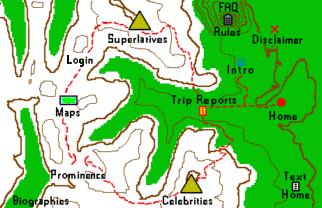
| Family Affair Voting Scheme - Schulze Method * |

|
The longstanding definition of how Family Affair FRL counts are obtained is simply to total the county numbers of all family members.
This definition, although quite obvious, was questioned by Jerry Brekhus in 2007. Jerry cited numerous alternative definitions with appealing properties. Unfortunately, his thoughts were initially neglected by the county highpointing community.
Adam Helman re-introduced the topic, as he viewed the longstanding definition as ill-conceived from the aspect of maintaining FRL categories that reward unique aspects of the hobby. An orthogonality principle. Often a single, avid highpointer runs-up the total family count, while other members climb almost nothing. There results Family Affair counts that are nearly identical to said highpointer's Century Club count. Indeed, this state of affairs was sufficiently displeasing to one mathematics professor (and stellar highpointer) as to request exclusion of his family count from future Front Runner Lists.
In private discussion, Jerry, Adam, and Dave Covill produced several alternative Family Affair count definitions. Alternative formulations were then solicited from the county highpointing community at-large, so allowing Edward Earl to add another definition to the possible replacements for the longstanding one.
Definitions and Example
An example of using the five DEFINITIONS follows for a hypothetical Peakbagger family.
Upper and lower case signify that the same county was visited at different times,
e.g., "M" and "m" represent different hikes to County M.
The Peakbagger Family:
Grandma AB (2 counties)
Patty Peakbagger ABCDEFGHIJk mnopqrstuvwxyz (25 counties)
Peter Peakbagger CDE GHIJ LM (9 counties)
Billy Bob (child) A CDE g k mn q XYZ (12 counties)
Sally Sue (child) EFG (3 counties)
Using DEFINITIONS II, III, and IV -
Family of Two 12 12 8
Family of Three 9 5 3
Family of Four 3 2 1
Three Generations 2 1 1
Two Siblings 3 2 1
Three Siblings (not applicable)
Using DEFINITIONS I and V -
Traditional Family Any Size 49 24
Three Generations 39 14
Siblings Any Number 15 3
A Condorcet method was proposed by Adam Helman and Edward Earl independently. Edward then refined the choice by focusing on the Schulze method owing to its important mathematical properties. He wrote software to compute the Condorcet matrix based on the "strength" of paths from pairs of candidate definitions.
Highpointers were then instructed to rank DEFINITIONS by their preference. As credit to the Schulze method one may rank a subset of DEFINITIONS; and return a ballot even when some DEFINITIONS are considered of equal rank. This flexibility is a major criterion for why Schulze was selected as the voting method of choice.
Cast Ballots and ResultsEleven ballots were cast and returned to Adam Helman (including his own).
Notation: a - b - c - d - e has DEFINITION "a" ranked first, DEFINITION "b" ranked second, etc....
Voter 1 : III - IV - II - V - I
Voter 2 : V - {II,III,IV} - I
Voter 3 : III - IV
Voter 4 : III - IV - II - V - I
Voter 5 : III - IV - II - V - I
The resulting Condorcet matrix -
| I | II | III | IV | V | |
| *** | *** | *** | *** | *** | |
| I | 0 | 2 | 4 | 4 | 1 |
| II | 7 | 0 | 3 | 3 | 5 |
| III | 7 | 5 | 0 | 7 | 6 |
| IV | 7 | 5 | 1 | 0 | 6 |
| V | 8 | 3 | 4 | 4 | 0 |
DEFINITION III is the top-ranked definition:
count only counties claimed by every member of the family group.
It shall be used in all subsequent Family Affair Front Runner Lists.
The longstanding definition, as DEFINITION I, was ranked dead last.
The complete ranking is III - IV - II - V - I.